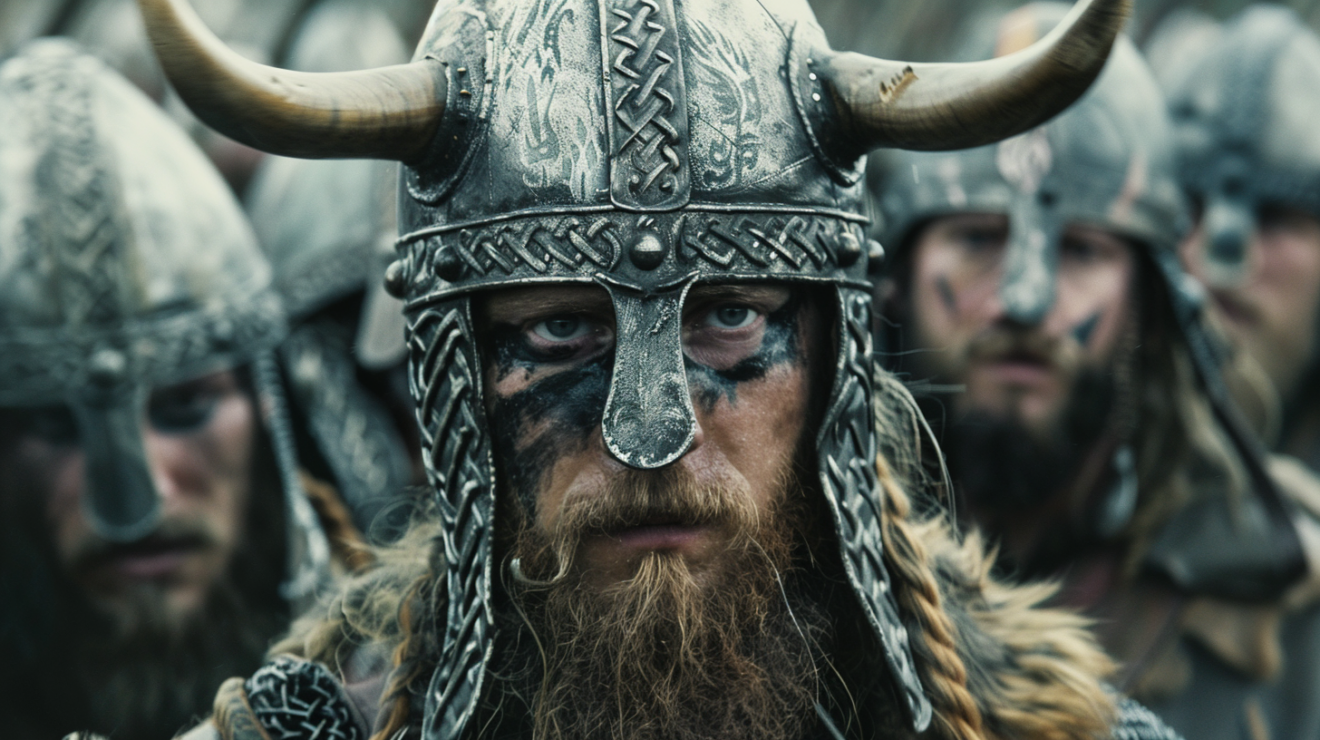So, you’ve heard about Vikings and their iconic horned helmets, right?
Well, let’s set the record straight. It’s time to debunk this long-standing myth and uncover the truth behind what Vikings really wore into battle as we unravel the fascinating history and separate fact from fiction when it comes to these legendary Norse warriors.
Origin of the Horned Helmet Myth

The myth of Vikings wearing horned helmets traces back to costume designer Carl Emil Doepler in 1876. Despite Doepler’s artistic vision, historical evidence indicates that Vikings didn’t wear horned helmets. This misconception stemmed from Doepler’s fusion of Norse and Germanic history, influenced by German cultural elements. By incorporating horned helmets into his designs, Doepler inadvertently perpetuated a false narrative about Viking headgear.
The myth of Viking horned helmets gained traction through invented Viking Age stories that featured these exaggerated helmets. While the misconception became widely accepted in popular culture, Scandinavian countries, more in touch with their own history, didn’t fall for this myth. This false belief has complicated the historical understanding of the Norse people, leading to a detective story of separating fact from fiction. Despite the enduring image of Vikings with horned helmets, it’s essential to recognize that this portrayal is a product of artistic interpretation rather than historical accuracy.
Historical Inaccuracies in Viking Depictions

In popular culture, misconceptions about Viking depictions often overshadow historical accuracy. One prevalent myth is the idea that Vikings wore horned helmets into battle. Contrary to this belief, Viking warriors never actually donned such headgear.
The myth of horned Viking helmets gained traction in the 19th century, thanks to costume designer Carl Emil Doepler, who incorporated this dramatic element into his designs. However, historical evidence paints a different picture. Only one complete Viking-Age helmet has ever been unearthed, and it was devoid of any horns.
Viking historians frequently debunk the notion of horned helmets, emphasizing the lack of authentic sources supporting this claim. Neil Price’s book ‘The Children of Ash and Elm’ further solidifies this argument, highlighting the absence of horns in Viking helmet designs.
When considering Viking depictions, it’s essential to separate fact from fiction and acknowledge the historical inaccuracies perpetuated by popular culture.
The Real Viking Headgear Revealed

Despite the long-standing myth of horned Viking helmets, the truth behind the real Viking headgear reveals a diverse array of historically accurate designs. Viking warriors never actually wore horned helmets, as depicted in popular culture. In fact, only one complete Viking-Age helmet has been discovered, and it had no horns. The myth of horned Viking helmets originated in the 19th century and isn’t historically accurate.
To uncover the true diversity of Viking headgear, one must look at historical artifacts like the Viksø helmets. These helmets, dating back to the Iron Age, showcase the authentic styles worn by Viking warriors. Costume designer Carl, inspired by discoveries like the Viksø helmets, creates historically faithful Viking headgear for movies and reenactments.
Viking historians diligently debunk the misconception of horned helmets to uphold historical accuracy and provide a more truthful representation of these formidable warriors. By understanding the reality of Viking headgear, one gains a deeper appreciation for the rich and varied history of this fascinating culture.
Impact of False Imagery on Viking Perception

Revealing the consequences of false imagery on how Vikings are perceived is essential for setting the record straight about their historical identity. Vikings didn’t wear horned helmets, yet this misconception has persisted due to costume designs by individuals like Carl Emil Doepler in the 19th century. This myth infiltrated popular imagination through mediums like Wagner’s operas, despite lacking historical basis.
The portrayal of Vikings with horned helmets diminishes the true image of these skilled warriors and seafarers, distorting their legacy. Scandinavian countries have actively worked towards debunking this myth, aiming to present a more accurate representation of Viking history.
Understanding the impact of false imagery on Viking perception is vital for dispelling misconceptions about their cultural practices and appearance. By unraveling these myths and embracing the authentic Viking heritage, we can appreciate their true identity beyond the embellishments of fictionalized imagery.
Dissecting the Costume Designer’s Influence

Exploring the influence of costume designers is crucial for revealing the origins of the Viking horned helmet myth. Vikings didn’t wear helmets with horns; this misconception can be traced back to costume designer Carl Emil Doepler in 1876. Doepler’s design, influenced by a blend of Norse and German history, created a powerful myth surrounding the Viking Age. This misconception has persisted through popular imagery and cultural representations, shaping public perception of Vikings. Remarkably, Scandinavian countries, with a real history of Viking exploration and plunder, haven’t fallen for the myth of horned helmets, demonstrating a deeper understanding of their own history.
Dissecting the influence of costume designers like Doepler helps unravel the complex historical detective story behind misconceptions about Viking headgear. By understanding the origins of these myths, we can appreciate the impact of visual representation on historical narratives. The legacy of Doepler’s design serves as a reminder of how artistic interpretation can shape our perception of the past.
Unraveling the Truth About Viking Attire

Exploring the reality of Viking attire uncovers a stark contrast to the myth of horned helmets perpetuated through history. Contrary to popular belief, Viking warriors never wore horned helmets in battle during the Viking era. The only complete Viking-Age helmet discovered, dating back to the Bronze Age, had no horns, emphasizing the practicality and functionality of Viking headgear in combat situations. Historical evidence suggests that any depiction of horned helmets was more likely reserved for ceremonial purposes and decoration rather than actual warfare.
The misconception of Vikings wearing horned helmets gained traction in the 19th century, perpetuated by artists such as Carl Emil Doepler. However, recent research, such as Neil Price’s book ‘The Children of Ash and Elm,’ has shed light on the historical truth, emphasizing the lack of horns on Viking helmets. This new understanding challenges the long-standing misrepresentation and highlights the importance of separating fact from fiction when it comes to Viking attire.
Revisiting Popular Misconceptions About Vikings

Contrary to popular belief, Vikings didn’t wear horned helmets into battle. The myth of horned Viking helmets actually originated in 1876 with costume designer Carl Emil Doepler and not from any historical evidence.
While artifacts like the Viksø helmets from around 900 BC in Denmark do showcase horned headgear, these were likely used for ceremonial purposes rather than combat. The National Museum in Copenhagen also houses examples of helmets made by the Vikings, none of which feature horns.
Despite the lack of archaeological evidence supporting the existence of horned Viking helmets, the misconception has persisted through imagery and media representations. Understanding the true history of Viking helmets allows for a deeper appreciation of their actual designs and cultural significance.










Add Comment